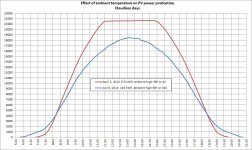Redneck in training
Elite Member
Dave,
Just found this thread and haven't had a chance to read it all the way through. But I was wondering how much this had actually reduced your utility bills. How much of your usage did you intend on replacing. Seems like you are running as expected maybe a little better.
We don't have net metering. Our electric bill is about $200/month less. Predicted pay back is about 15 years. If the cost of power goes up or we buy electric car it might be significantly shorter. I estimate that with net metering our system would be paid off in about 8 years because of our electric bill would be zero.
Our utility is hostile to alternative sources of energy. We used to have a discount heating rate during winter and since I generate my own power they took it away.
BTW we are on our way to about match the predicted energy generated 36MWh.
So to answer your question: It depends on the deal you get from your utility and size of the system.
If you get net metering it is best to match your yearly consumption.
